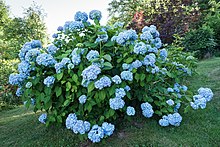Hydrangeaceae: Difference between revisions
| Line 16: | Line 16: | ||
==Overview== |
==Overview== |
||
In its broad sense (as treated by the [[Angiosperm Phylogeny Group]]), the family includes 17 genera, but some botanists divide the family into two, with seven genera split off into a separate family, '''Philadelphaceae'''. |
In its broad sense (as treated by the [[Angiosperm Phylogeny Group]]), the family includes 17 genera, but some botanists divide the family into two, with seven genera split off into a separate family, '''Philadelphaceae'''. The genera of Hydrangeaceae were formerly included in a much broader (but polyphyletic) [[Saxifragaceae]]. |
||
The genera are characterised by [[leaf|leaves]] in opposite pairs (rarely whorled or alternate), and regular, bisexual [[flower]]s with 4 (rarely 5–12) petals. The [[fruit]] is a [[capsule (fruit)|capsule]] or [[Berry (botany)|berry]] containing several [[seed]]s, the seeds with a fleshy [[endosperm]]. |
The genera are characterised by [[leaf|leaves]] in opposite pairs (rarely whorled or alternate), and regular, bisexual [[flower]]s with 4 (rarely 5–12) petals. The [[fruit]] is a [[capsule (fruit)|capsule]] or [[Berry (botany)|berry]] containing several [[seed]]s, the seeds with a fleshy [[endosperm]]. |
||
Revision as of 15:00, 3 November 2019
| Hydrangeaceae | |
|---|---|

| |
| Hydrangea macrophylla | |
| Scientific classification | |
| Kingdom: | Plantae |
| Clade: | Tracheophytes |
| Clade: | Angiosperms |
| Clade: | Eudicots |
| Clade: | Asterids |
| Order: | Cornales |
| Family: | Hydrangeaceae Dumort.[1] |
| Genera | |
|
See text | |
| Synonyms | |
| |

Hydrangeaceae is a family of flowering plants in the order Cornales, with a wide distribution in Asia and North America, and locally in southeastern Europe. it comprises nine (or fewer) genera with 223 known species.[3]
Overview
In its broad sense (as treated by the Angiosperm Phylogeny Group), the family includes 17 genera, but some botanists divide the family into two, with seven genera split off into a separate family, Philadelphaceae. The genera of Hydrangeaceae were formerly included in a much broader (but polyphyletic) Saxifragaceae.
The genera are characterised by leaves in opposite pairs (rarely whorled or alternate), and regular, bisexual flowers with 4 (rarely 5–12) petals. The fruit is a capsule or berry containing several seeds, the seeds with a fleshy endosperm.
Genera
|
|
In addition, the genus Pottingeria is sometimes included in Hydrangeaceae, while others treat it in either Celastraceae, or in its own family Pottingeriaceae.
References
- ^ Angiosperm Phylogeny Group (2009). "An update of the Angiosperm Phylogeny Group classification for the orders and families of flowering plants: APG III" (PDF). Botanical Journal of the Linnean Society. 161 (2): 105–121. doi:10.1111/j.1095-8339.2009.00996.x. Retrieved 2013-07-06.
- ^ "Family: Hydrangeaceae Dumort., nom. cons". Germplasm Resources Information Network. United States Department of Agriculture. 2003-01-17. Retrieved 2012-07-31.
- ^ Christenhusz, M. J. M.; Byng, J. W. (2016). "The number of known plants species in the world and its annual increase". Phytotaxa. 261 (3): 201–217. doi:10.11646/phytotaxa.261.3.1.
- ^ "GRIN Genera of Hydrangeaceae". Germplasm Resources Information Network. United States Department of Agriculture. Archived from the original on 2004-11-18. Retrieved 2012-07-31.
External links
 Media related to Hydrangeaceae at Wikimedia Commons
Media related to Hydrangeaceae at Wikimedia Commons Data related to Hydrangeaceae at Wikispecies
Data related to Hydrangeaceae at Wikispecies
